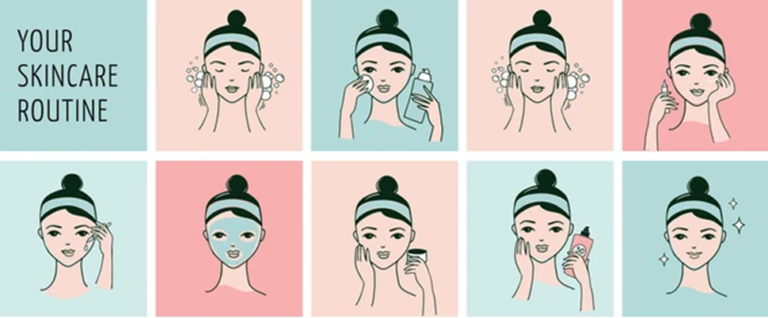Exfoliate Your Skin the Right Way- Ideal Frequency Explained
Exfoliation is a vital component of basic skincare. It eliminates dead skin cells, revealing a bright, healthy complexion. But, how frequently should you exfoliate your skin? The answer is dependent on your skin type, lifestyle, and the exfoliant you use.

Why Should I Exfoliate My Skin?
Exfoliating your skin has many benefits. It removes dead skin cells that can clog pores. This prevents blackheads, acne, and dullness.
Regular exfoliation improves your skin’s texture. It makes your skin smoother and softer. It also evens out your skin tone.
Exfoliating enhances product absorption. Your serums and moisturizers work better. This boosts your basic skincare routine.
How Often Should I Exfoliate My Skin?
The frequency depends on your skin type:
Over-exfoliating can damage your skin barrier. It leads to redness, irritation, and sensitivity. Start slowly and observe how your skin reacts.
Exfoliating Sensitive Skin
Sensitive skin is prone to irritation. Be gentle when you exfoliate your skin. Use mild chemical exfoliants like lactic acid.
Exfoliate your skin only once a week. Avoid physical scrubs, as they can be too abrasive. Always follow with a soothing moisturizer.

Exfoliating Dry Skin
Dry skin needs exfoliation to remove flaky patches. But over-exfoliating can worsen dryness. Choose hydrating chemical exfoliants with hyaluronic acid.
Exfoliate your skin once or twice a week. Avoid harsh physical scrubs that can cause microtears.
Exfoliating Normal Skin
Normal skin can handle more frequent exfoliation. You can exfoliate your skin two to three times a week.
Alternate between chemical and gentle physical exfoliants. This prevents over-exfoliation and keeps your skin balanced.
Exfoliating Oily or Acne-Prone Skin
Oily and acne-prone skin benefits from regular exfoliation. It removes excess oil and unclogs pores. This reduces breakouts and blackheads.

Exfoliate your skin two or three times per week. Use chemical exfoliants, such as salicylic acid. They penetrate the pores and regulate oil production.
Avoid using hard physical scrubbing. They can aggravate acne and increase irritation.
Chemical vs. Physical Exfoliation
There are two main types of exfoliants: chemical and physical. Knowing the difference helps you choose the right one for your skin.

What is Chemical Exfoliation?
Chemical exfoliants use acids or enzymes. They dissolve dead skin cells without scrubbing. This makes them gentler and more effective.
Common chemical exfoliants include:
- Alpha Hydroxy Acids (AHAs) – Glycolic and lactic acid. They exfoliate the surface, brightening dull skin. Ideal for dry and sensitive skin.
- Beta Hydroxy Acids (BHAs) – Salicylic acid. It penetrates pores, removing excess oil. Great for oily and acne-prone skin.
- Polyhydroxy Acids (PHAs) – Gluconolactone. They are gentle and suitable for sensitive skin.
- Enzymes – Papaya and pineapple enzymes. They dissolve dead cells without irritation.
Chemical exfoliants are perfect for sensitive skin. They don’t require scrubbing, reducing the risk of microtears.
Benefits of Chemical Exfoliation
- Gentle and effective – No need for harsh scrubbing.
- Even exfoliation – Dissolves dead cells uniformly.
- Penetrates deeper – Improves texture and reduces fine lines.
- Suitable for all skin types – Different acids for different needs.
Drawbacks of Chemical Exfoliation
- Sun sensitivity – Always wear sunscreen after use.
- Possible irritation – Start with a low concentration and patch test.
- Not suitable for broken or inflamed skin – It can worsen irritation.
What is Physical Exfoliation?
Physical exfoliants use scrubs or tools. They manually remove dead skin cells. Common physical exfoliants include:
- Scrubs – Contain particles like sugar, salt, or jojoba beads.
- Brushes – Facial brushes with soft bristles.
- Exfoliating Cloths or Mitts – Buff away dead skin manually.
Physical exfoliants are effective for immediate smoothness. But they can be harsh if overused or applied with too much pressure.
Benefits of Physical Exfoliation
- Instant results – Smooth, soft skin after one use.
- Easy to use – No waiting time or complicated steps.
- Affordable – Widely available and budget-friendly.
Drawbacks of Physical Exfoliation
- Harsh on sensitive skin – Can cause microtears and irritation.
- Uneven exfoliation – Depends on pressure and technique.
- Can worsen acne – Scrubbing inflamed pimples spreads bacteria.
Which is Better: Chemical or Physical Exfoliation?
Both types have pros and cons. It depends on your skin type and concerns.
- Chemical exfoliants are gentler and more consistent. Ideal for sensitive, dry, or aging skin.
- Physical exfoliants provide instant smoothness. Suitable for normal or combination skin.
For oily or acne-prone skin, chemical exfoliants like BHAs are better. They penetrate pores and reduce oiliness.
Can You Use Both Chemical and Physical Exfoliation?
Yes, but with caution. Don’t use them on the same day. This can over-exfoliate and damage your skin barrier.
Alternate between them for balanced exfoliation. For example, use a chemical exfoliant once a week and a gentle scrub another day.
How to Incorporate Exfoliation in Basic Skincare

Your basic skincare routine should include:
- Cleansing – Removes dirt and oil.
- Exfoliating – Unclogs pores and removes dead skin cells.
- Toning – Balances pH and preps for moisturizer.
- Moisturizing – Hydrates and protects the skin barrier.
- Sunscreen (Day Only) – Protects from UV damage.
Exfoliate your skin after cleansing but before toning. This allows serums and moisturizers to penetrate better.
Can I Exfoliate Every Day?
No, daily exfoliation can harm your skin. It weakens the barrier and causes irritation. Stick to the recommended frequency based on your skin type.
Signs of Over-Exfoliation
- Redness and irritation.
- Increased sensitivity.
- Dryness or peeling.
- Breakouts or inflammation.

If you notice these signs, stop exfoliating. Focus on soothing and hydrating products. Allow your skin to recover before resuming.
Conclusion
How often should you exfoliate your skin? It depends on your skin type and the product used. Sensitive skin should exfoliate once a week. Oily or acne-prone skin can exfoliate two to three times a week.
Choose chemical exfoliants for gentler, more effective results. Avoid harsh physical scrubs that can cause irritation.
Exfoliating your skin enhances your basic skincare routine. It improves texture, prevents breakouts, and boosts product absorption.
But remember, moderation is key. Over-exfoliating damages your skin barrier. Stick to the recommended frequency and always wear sunscreen.
Listen to your skin’s needs. Adjust your routine as needed. When done correctly, exfoliation maintains your skin healthy, smooth, and radiant.
FAQ’s
How often should I exfoliate my skin if I have sensitive skin?
Can I exfoliate my skin every day?
How often should I exfoliate if I have oily skin?
Should I exfoliate in the morning or at night?
Can I use both chemical and physical exfoliants?
How do I know if I’m over-exfoliating my skin?
Can I exfoliate before or after shaving?
Is it necessary to exfoliate if I have dry skin?
Do I need to use sunscreen after exfoliating?
What’s the difference between chemical and physical exfoliation?






